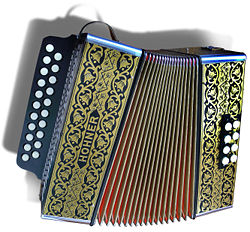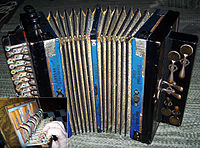- Diatonic button accordion
-
Diatonic Button Accordion 
Classification Musicians List of accordionists More articles Accordion, Chromatic button accordion, Bayan, Diatonic button accordion, Piano accordion, Stradella bass system, Free-bass system, Accordion reed ranks & switches A diatonic button accordion or melodeon is a type of button accordion where the melody-side keyboard is limited to the notes of diatonic scales in a small number of keys (sometimes only one). The bass side usually contains the principal chords of the instrument's key and the root notes of those chords.
Contents
Melodeon
There is some geographic disagreement over the terms button accordion and melodeon. In England a bisonoric (different note on push and draw of the bellows) instrument with one, two or three rows of buttons on the right hand (melody) side is likely to be called a melodeon. In Ireland a melodeon refers only to one-row instruments, while in the southern United States even these are called accordions[1].
The available notes on the melody side are based on different keys. For example, you could have a 1-row melodeon in the key of G. This would give you the notes G/A - B/C - D/E - F#/G spread over 4 buttons. Commonly used melodeons nowadays include the D/G box with 2 rows, used especially in English traditional music (particularly for the accompaniment of social and Morris dancing), while instruments in G/C, C/F or G/C/F (with three treble rows of buttons), are widely used in France, Italy and central/eastern Europe.
The three-row button accordion is also popular in Mexico and the United States (in Conjunto, Tejano, Zydeco and Cajun musics) and Columbia (in Vallenato & Folklor musics). This system of note organization is also commonly referred to as the "International System." This system involves each row being tuned a fourth apart (ex: Bb/Eb/Ab; A/D/G; G/C/F; F/Bb/Eb or E/A/D).
Irish traditional musicians generally favour instruments in B/C or C#/D. Because the keys of the latter are a semitone apart, all the notes of the chromatic scale are in theory available (unlike the D/G box or others where the interval is a fourth).
There are many variations on these layouts, with 2½ row melodeons (a.k.a. "Club" system after the Hohner originals[2]), accidentals and various options which players sometimes customize to suit their own requirements.
The two-row melodeon (tuned in fourths) is apparently limited by being able to play only in its two given major keys - e.g. D and G, and their associated minor keys of B and E. However some tunes in the major keys of E and A can also be managed, and in practice most British and Irish traditional music, and North American music with these roots, strays little from this limited set of keys. The vast majority of the traditional repertoire can be played using just fourteen notes available on all two-row melodeons[3].
A majority of the traditional Irish tunes are based on the modes around the key of D major, those keys are easiest to handle. However, since every tune has its own combination of bellows work, it's about as easy or difficult to play in any of the keys of the general repertoire.
Well known melodeon players currently recording include English musicians John Spiers (of Spiers and Boden and Bellowhead), Saul Rose, John Kirkpatrick, Andy Cutting (of Blowzabella) and Tim van Eyken. There are also many current or recently deceased non-English players whose recordings can be easily located outside their home countries, including Marc Perrone (France), Riccardo Tesi (Italy), Máirtín O'Connor (Ireland), Bobby Gardiner Ireland, Sharon Shannon (Ireland), Marc Savoy (Louisiana Cajun), Yves Lambert (Quebec, Canada), Kepa Junkera (Basque), John Delafose (Louisiana "zydeco"), Boozoo Chavis (Louisiana "zydeco"), Flaco Jimenez (United States "conjunto" musician) and Israel Romero (Colombian Vallenato Musician).
Polka box
Steirische Harmonika[notes 1] or Slovenian-style box is very popular in the Alpine region of Europe. This type of box was also made in the U.S. by Anton Mervar Button Accordion Manufacturer (1885-1942), inducted on November 30, 1991. The main differences are the use of bigger, deeper bass reeds (Helicon reeds) and the single unisonoric note in each RH row but one.
Hybrids
Most diatonic button accordions (e.g.: melodeon) are bisonoric, meaning each button produces two notes: one when the bellows is compressed, another while it is expanded; other instruments (e.g.: Garmon) are unisonoric, with each producing the same note regardless of bellows direction; still others (e.g.: schwyzerörgeli, trikitixa) have a combination of the two types of action.
Repertoire
Classical
- Dances from a New England Album, 1856 for orchestra by William Bergsma includes parts for melodeon (movements I-III) and harmonium (movement IV).
Notes
- ^ de:Bild:Schwarz-kaerntnerlkand.jpg Picture of Steirische Harmonika
See also
References
- ^ Mallinson, Dave. The D/G Melodeon. Cleckheaton, Yorkshire: mally.com (2002) ISBN 1-899512-01-2. Page 3.
- ^ http://www.fontanabuttonaccordionclub.org/Pages/Accordion.html
- ^ Mallinson, The D/G Melodeon. Page 11.
External links
Bayan · Button · Cajun accordion · Chromatic button accordion · Diatonic button accordion/Melodeon · Flutina · Garmon' · Livenka · Piano accordion · Saratovskaya Garmonika · Schrammel accordion · Schwyzerörgeli · Steirische Harmonika · TrikitixaConcertinas Categories:- Keyboard instruments
- Sets of free reeds
- Celtic musical instruments
Wikimedia Foundation. 2010.


